Chow mein is a popular Chinese dish of stir fried noodles with mix vegetables, soy sauce, aromatics and spices. My street style veg chowmein recipe is a delightful Indo-Chinese fusion. This vegan dish is a savory masterpiece of smooth, velvety noodles and oodles of crunchy veggies. You’re sure to fall in love with this Asian noodles dish; it is utterly slurp-able to the last bite.

About Chow Mein Recipe
Making veg chow mein is as easy as stir-frying noodles and veggies together. In fact, if the vegetables are already chopped for you, the whole dish comes together in just minutes!
For this reason, I highly recommend you get out your food processor; it’ll make the whole process a snap.
This particular recipe is inspired by the taste of chow mein served from Indian street carts. The tangle of noodles and vegetables are tossed in a tangy-sweet sauce that is nearly addictive. It is a favorite in our house.
Making chowmein recipe at home is actually quite easy, as this recipe will soon show. It is also entirely customizable based on your needs.
If you are gluten-free, simply swap in gluten-free noodles of your choice and opt for tamari or coconut aminos in place of the soy sauce.
You can also swap in your own favorite assortment of vegetables, making this a lovely recipe for cleaning out your crisper drawer at the end of the week.
If you are looking for an easy way to get your kids to eat more veggies, this chow mein recipe is a great place to start. For a healthier option I recommend using whole wheat noodles or buckwheat noodles.
You can also check out other veg noodles recipes on the blog like:
Serve this veg chowmein with or without any sauce or accompaniments. You’re sure to love them either way!
How to Make Chow Mein
Veggie Prep and Cook Noodles
1. Bring 5 cups of water to a boil. Add ¼ teaspoon salt to the water.

2. Add 150 to 200 grams noodles. No need to break them. Here I have used hakka noodles. But you can use whole wheat noodles, soba noodles (buckwheat noodles) or chowmein noodles or ramen noodles.
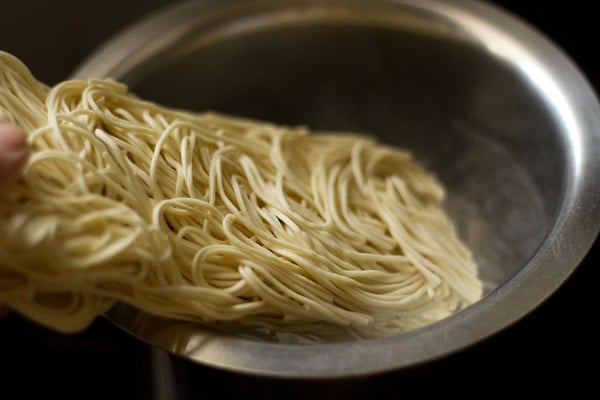
3. Cook the noodles according to package directions.
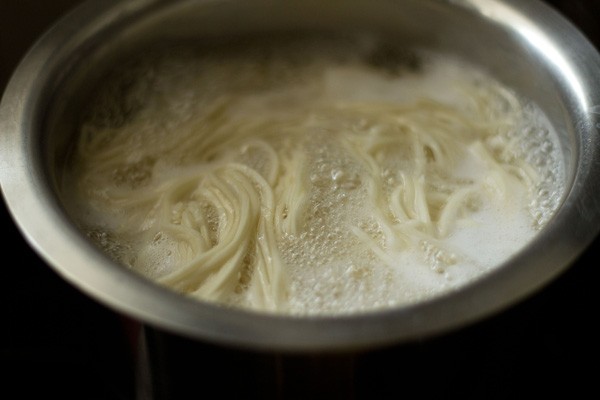
4. Allow the noodles to cook until tender and softened. You don’t need to cook the noodles al dente as later we only toss the noodles with the stir-fried veggies and do not cook them further. But if you prefer, you can cook them until al dente.
Different types of noodles require different cooking times, so prepare noodles according to the package instructions.
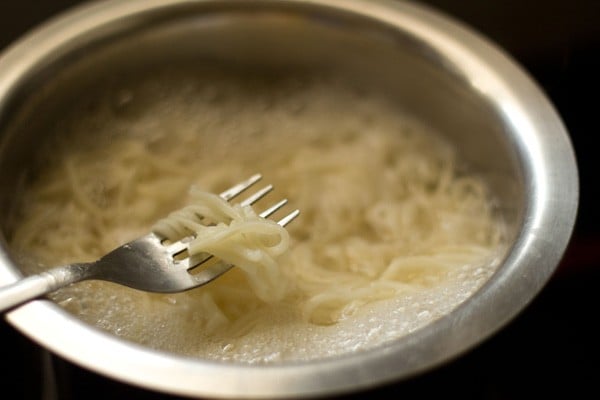
5. Drain the cooked noodles in a colander.
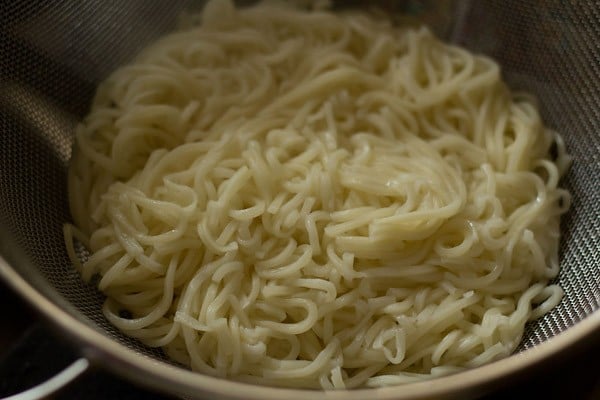
6. Rinse the noodles very well under running water to stop the cooking process.
7. Add 1 to 2 teaspoons of toasted sesame oil to the noodles. You can also use any neutral-flavored oil.

8. Toss them well so that the oil gets coated evenly on the noodles to prevent them from sticking together. Cover and keep the noodles aside.
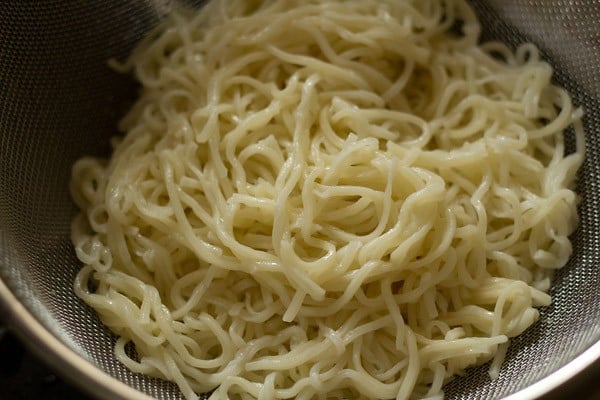
9. While the noodles are cooking, chop and grate the veggies. Also chop the button mushrooms. Set aside.

10. Prepare cornflour (aka cornstarch) slurry with 2 teaspoons cornflour and 2 tablespoons water. Keep aside.

Make Veg Chow Mein
11. Heat 2.5 to 3 tablespoons of oil in a pan or wok on medium heat. You can use any neutral-flavored oil.
Add the following ingredients:
- 2 to 3 teaspoons finely chopped green chilies
- 1 teaspoon finely chopped ginger
- 1 teaspoon finely chopped garlic
Sauté the green chilies, ginger and garlic for about 20 to 30 seconds. Green chilies add quite some heat to the dish. Skip if you do not prefer them or if making for kids.

12. Add ⅓ cup finely chopped onions. Stir and sauté for a minute. Instead of onions, you can use spring onion whites (like in the recipe video) or shallots.

13. Add ¾ to 1 cup sliced button mushrooms and ¼ to ⅓ cup finely chopped french beans.

14. Stir and sauté on medium heat till the edges of the mushrooms get lightly browned.

15. Add the following ingredients:
- ¾ cup grated or shredded carrots
- ¾ cup shredded cabbage, green or purple cabbage
- 1 teaspoon finely chopped celery, optional
- ¼ cup thinly sliced capsicum (bell pepper)
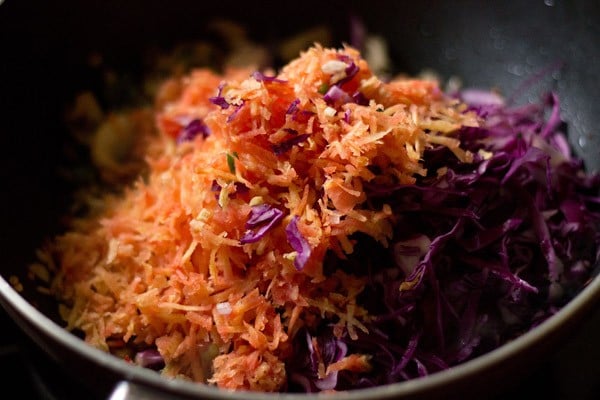
16. Stir and increase the heat to a high. Stir fry everything on high heat for 2 to 3 minutes.
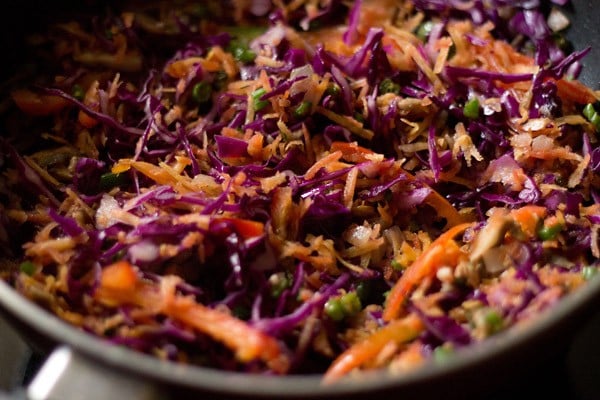
17. Add 3 teaspoons soy sauce. At this step you can also add tomato sauce or red chili sauce/green chili sauce. Since I already added green chilies, I did not add chili sauce.
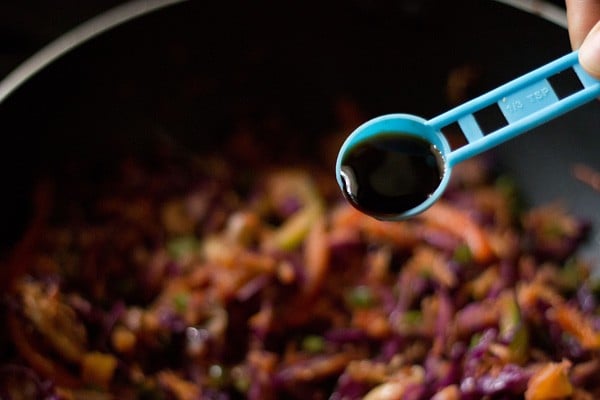
18. Add ½ teaspoon black pepper or white pepper powder or add as required

19. Season with salt as required. At this step you can also choose to add tofu cubes or sprouts. Add them and stir fry for a minute.
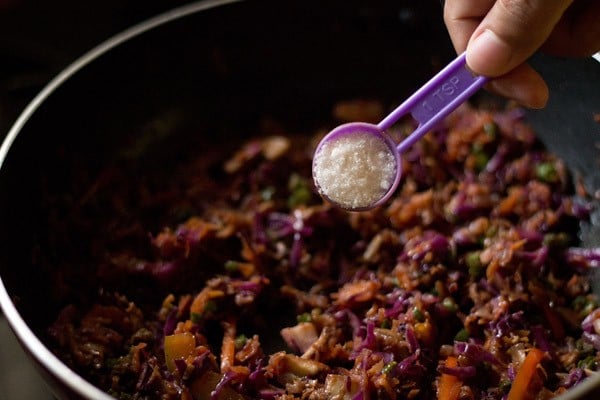
20. Stir everything and then add the cornflour slurry.
Be sure to stir the cornflour paste before adding it to the vegetables and keep the heat to a low.
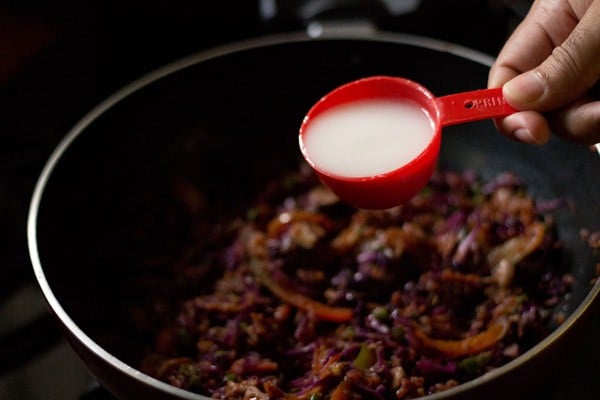
21. Stir and sauté for a minute on medium-low heat.
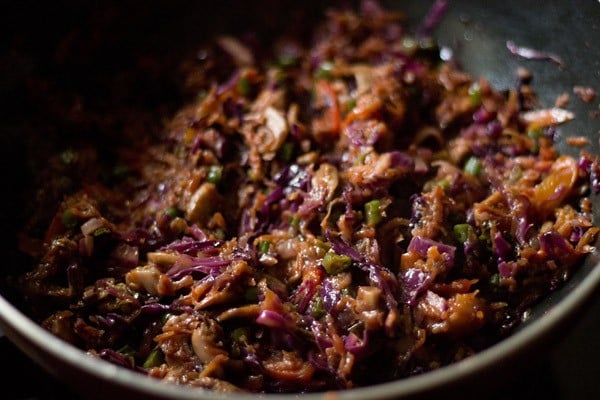
22. Add the cooked noodles and increase the heat again.

23. Stir and quickly toss the noodles with the veggie mixture. A lot of handwork is required while tossing and mixing the noodles.

24. Lastly, add ½ teaspoon rice vinegar and give a final mix to chowmein. Remove from heat.
You can also use apple cider vinegar or white vinegar in place of rice vinegar. If you are not fond of vinegar then feel free to skip adding it.
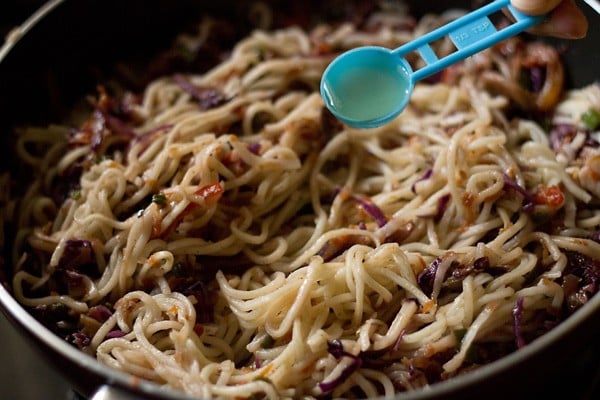
25. Serve veg chowmein steaming hot. Feel free to garnish with 1 to 2 teaspoon toasted sesame seeds and some spring onion greens.
I recommend to enjoy a bowl of chow mein noodles steaming hot for the best taste and flavor.

Expert Tips & Variations
Making chow mein is as easy as making any other stir-fry. To ensure smooth sailing, be sure to note the following tips:
- Remember to keep all the sauces and seasonings ready when you begin to stir fry the veggies. You won’t have the time to go fishing through your pantry once you start the process!
- I add a cornstarch slurry to the noodles, which results in a smooth, velvety texture for the sauce. You can completely skip adding cornflour paste if corn is not part of your diet.
While this simple veg chowmein noodles is wonderful as written, there are plenty of ways to customize it to your liking. Here are a few ideas:
- Add your choice of noodles and veggies. You can opt for regular wheat or whole wheat noodles, egg noodles or gluten free noodles. Any veggies that you would normally stir fry will taste great here, so feel free to use whatever you have on hand.
- If you include eggs in your diet, you can add a scrambled egg or two to the stir fry near the end of cooking.
- If you are not fond of mushrooms, try adding tofu, paneer (Indian cottage cheese) or sprouts.
- This chow mein noodles recipe can also be made without alliums. Just skip the onion and garlic.
- To get a sweeter tangy sauce, increase the amount of tomato ketchup you add.
- To make a more mild version of the sauce, omit the green chiles. This is advisable if you are making veg chowmein for kids.
- If you are gluten free, opt for tamari or coconut aminos instead of soy sauce.
FAQs
Not at all. While I love the smooth, velvety texture the cornstarch gives the sauce, you can easily omit it if corn is not part of your diet. You can also try to achieve the same silky effect by making a slurry of arrowroot or potato flour instead.
Sure! Simply swap in coconut aminos or Bragg’s liquid aminos in place of the soy sauce. Alternatively, you can use a touch of tamarind sauce; just note that this option will give the veg chowmein a bit more of a sour/tangy flavor than the other substitutes.
Any long, slightly chewy noodles should do the trick. You can use anything from spaghetti to ramen noodles. If you are gluten free, simply swap in your favorite long noodle substitute. I opted to use hakka noodles, but traditionally chow mein is made using a wheat and egg based noodle.
More Recipes With Noodles!
Indo Chinese Recipes
Indo Chinese Recipes
Indo Chinese Recipes
Indo Chinese Recipes
Please be sure to rate the recipe in the recipe card or leave a comment below if you have made it. For more vegetarian inspirations, Sign Up for my emails or follow me on Instagram, Youtube, Facebook, Pinterest or Twitter.

Chow Mein Recipe (Vegetarian)
Ingredients
For cooking noodles
- 150 to 200 grams hakka noodles – swap with plain or whole wheat noodles, soba noodles or flat noodles or chow mein noodles
- 5 cups water
- ¼ teaspoon salt
- 2 teaspoons toasted sesame oil or any neutral flavored oil
For Cornstarch Slurry – Optional
- 2 teaspoons cornstarch
- 2 tablespoons water
Other Ingredients
- 2.5 to 3 tablespoons oil – any neutral flavored oil
- 2 to 3 teaspoons finely chopped green chilies (skip if making for small kids) or add ¾ to 1 teaspoon spicy red chili sauce or green chili sauce
- 1 teaspoon finely chopped ginger
- 1 teaspoon finely chopped garlic
- ⅓ cup finely chopped onions or ⅓ cup chopped spring onion whites – reserve the spring onion greens for garnish
- ¾ to 1 cup chopped button mushrooms
- ¼ to ⅓ cup finely chopped french beans
- ¾ cup grated carrots or shredded carrots
- ¾ cup shredded cabbage – green or purple cabbage
- ¼ cup thinly sliced capsicum (bell pepper) – can use green or yellow or red bell pepper
- 1 teaspoon finely chopped celery – optional
- ¼ cup sprouts – optional
- ⅓ to ½ cup tofu cubes – optional
- 3 teaspoons soy sauce or add as required
- 1 tablespoon tomato ketchup or add as required, optional
- ½ teaspoon ground black pepper or white pepper powder, add as required
- salt as required add in moderation as soy sauce already has a lot of salt
- ½ teaspoon rice vinegar or regular vinegar
For Garnish
- 1 to 2 teaspoon toasted sesame seeds
- 2 to 3 tablespoons chopped spring onion greens (scallion greens)
Instructions
Cooking noodles
- Cook noodles according to the package instructions. The noodles don't need to be cooked till al dente. Since towards the end we will be just tossing the noodles with the stir fried veggies. But if you prefer you can cook them until al dente.
- Drain the water from the cooked noodles in a colander. Rinse noodles in running water very well. This method stops the cooking process.
- Add toasted sesame oil to the noodles. Toss them well, so that the oil gets coated evenly on the noodles. This method gets rid of stickiness from the noodles. Cover and keep the noodles aside.
- When the noodles are cooking, you can chop and grate the veggies.
- Prepare corn starch slurry or paste with the cornstarch and water. Keep aside.
Making chow mein
- Heat oil in a pan or wok. On medium heat, first saute the green chilies, ginger and garlic for about 30 seconds. Green chilies add quite some heat in the dish. Skip if you do not prefer them or if making for kids.
- Add chopped onions or spring onions. Saute for a minute.
- Add sliced mushrooms and finely chopped french beans.
- Stir and saute on a medium heat till the edges of the mushroom get lightly browned.
- Add grated carrots, shredded cabbage and sliced bell pepper (capsicum).
- Stir and increase the heat to a high. Stir fry everything on a high heat for 2 to 3 minutes.
- Add soy sauce. At this step you can also add tomato sauce or red chili sauce or green chili sauce. Since I have already added green chilies, I have not added the chili sauce.
- Season with ground black pepper or white pepper and salt as required. Mix well. At this step you can opt to add sprouts or tofu. Add them and stir fry for a minute.
- Lower the heat and add the cornstarch paste. Stir the cornstarch paste in the bowl very well before adding to the stir fried vegetables.
- Mix and sauté for a minute on medium-low heat.
- Add the cooked noodles. Increase the heat to high. Mix and toss the noodles with the stir fried veggies.
- Lastly add vinegar and give a final mix to chowmein. Switch off the heat.
- Serve chow mein steaming hot in serving bowls.
- You can also garnish chowmein with about 1 to 2 teaspoon toasted sesame seeds and some chopped spring onion greens.
Video
Notes
- Remember to keep all the sauces and seasonings ready when you begin to stir fry the veggies.
- You can add veggies like cabbage, carrots, spring onions, zucchini, capsicum, french beans, bok choy, napa cabbage, broccoli, corn etc.
- You can use noodles variety like whole wheat noodles, ramen noodles, soba noodles, chow mein noodles, hakka noodles etc.
- To make gluten-free chowmein use your favorite brand of gluten-free noodles. Also swap soy sauce with tamari or coconut aminos or Bragg’s liquid aminos.
- You can add tofu or sprouts to the noodles.
- You can make it without onion and garlic also. If making for small kids, then skip the green chilies, black pepper and use whole wheat noodles or soba noodles.
- The recipe can be scaled to make a small or big batch as per your requirements.
Nutrition Info (Approximate Values)
Chow Mein recipe from the archives was first published on November 2014.

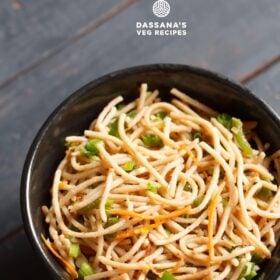

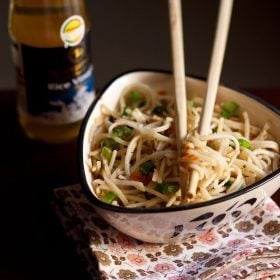

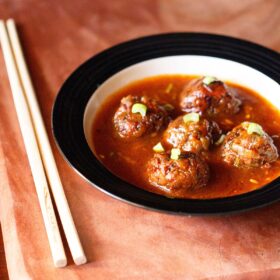

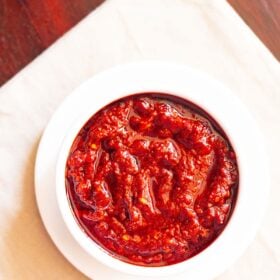
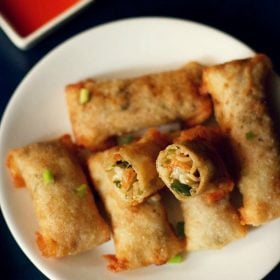








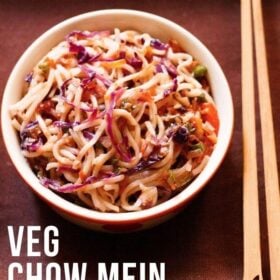
The more I am searching through your website, the more delicious recipes for myself i find! This is again one more yummy thing i loved when i was in India! I’m happy to cook it at home myself. Thank you so much!
Most welcome and do try this recipe. You will surely like it.
I have tried most of your recipes. I have no words to describe. Thank you is an understatement. My family, friends and I are great fans of yours. Cheers….
Welcome Latha. Thanks a lot for your kind words and positive feedback.
Hi,
This is Pratik here. Im really eager to try this recipe out. Only problem is I don’t know where to find corn starch. Im in Mumbai and looked in a couple of grocery stores but they don’t seem to know what it is. Can you please help me as to where I could buy it from?
Thank
just tell them corn flour. they will give you the packet. actually in india its called as corn flour outside india corn starch. many brands are available which sell corn flour in india.
Hey, thank you so much for the prompt reply. I’ll go ahead and do the same. Although to clear out this confusion I did look up the difference between the 2 and found out that they are not the same things. That’s why I thought I would ask.
Thanks
welcome pratik. the confusion is due to the fact that in west, the yellow colored maize flour is called as corn flour. in india we call it as makki ka atta. the white colored flour is called as corn starch in west and here we call it as corn flour. same thing, but different names.
Wow, Im really amazed with your knowledge about these things. Is there any other blog or some place where you keep writing about such things? I’ll make sure to follow you. Cause honestly this is not written anywhere so there is no way for people to know.
thanks a lot pratik. this is the only blog where i share whatever i know about food, cooking and recipes. many things i have learnt during my professional training in cooking as a student of home science.
Hi,
Thank you for the recipes. Haven’t tried any but I am sure they’ll be delicious. I miss indo-Chinese food. The restaurants here just don’t have that authentic taste except for far and few!
It would really appreciate it if you could clarify the following for me.
What is the difference between chowmein and Hakka noodles?
What is the difference between manchow soup and hot and sour soup?
I am in NYC. The celery generally available here is more stems and less leaves. What is preferable for your recipes?
Thanks!
thanks and welcome AA. your queries below:
1. hakka noodles is from the chinese cuisine. i have read that hakka cuisine originated in china from the hakka people. since the chinese inhabitants in india, were hakka people, these noodles here started being called as hakka noodles. chow mein is also from the chinese cuisine, but i think the original method or recipe has been adapted depending on the countries it is popular. both are stir fried noodles. whereas hakka noodles is always stir fried, chow mein has two variants – stir fried and fried. both taste different.
2. i suppose in the manchow soup noodles are added and in hot and sour soup, they are not.
3. celery stem is added. leaves can be skipped. i usually add celery stems.
loved it !….i was actually cooking it for the first time
thanks anu 🙂 for positive views.
hi dassana..need to know the role of cornstarch here..
farah, it makes the chow mein smooth and gives a glaze. if you want then you can skip also.
VERY GOOD
thankyou
the receipe looks good and easy to make . I wud love to make it. My son relishes noodles. The step by step picture presentation is very effective.thanks ..
glad you liked the veg chowmein noodles and thankyou for positive feedback 🙂
Why do we add corn starch mixture in this recipe?any specific reason
just to give a smooth and silky texture to the noodles. you can skip if you want.
I have tried so many recipies of yours. I have learnt a lot. Ur step by step procedure helps a lot. Everyone loves my cooked food. Thanks for such good recipies.
thanks a lot danish for this lovely feedback. happy cooking 🙂
I am regular visitor of ur blog n have tried a lot of ur recipes. Tried out the chow mein noodles last night and it was perfect ! I added some scrambled eggs at the end for my husband and he loved it !
pleased to know this glad your hubby liked the noodles 🙂 thankyou for your kind and positive words.
your site is amazing !!! I cook for my husband which indian and loves the dishes !!! thank you so much.
I love the picture guide as it always helps me .
pleased to know this helen 🙂 thankyou for your positive words and you are welcome.
Hi
Is corn starch same.as.cornflour which we use as a thickener in soups etc? Can i use cornflour for this recipe?
Thanks
in india, what we call as cornflour is basically corn starch – which is used as a thickening and binding agent.